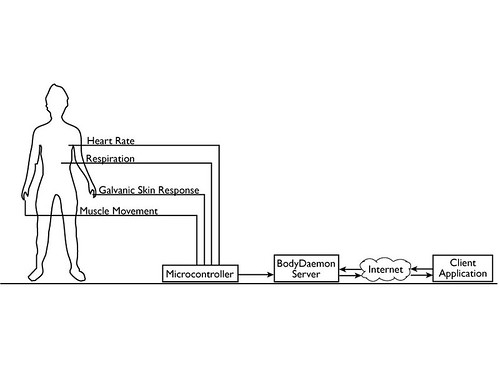A bio-responsive Internet server

Exhibitions: 2006 – ZeroOne/ISEA2006 in San Jose, California & San Jose State University Black Gallery
BodyDaemon is a bio-responsive Internet server. Readings taken from a participant’s physical states, as measured by custom biofeedback sensors, are used to power and configure a fully-functional Internet server. For example, more or fewer socket connections are made available based on heart rate, changes in galvanic skin response (GSR) can abruptly close sockets, and muscle movements (EMG) can send data to the client. Other feature’s such as logging can be turned on or off depending on a combination of factors. BodyDaemon also includes a client application that makes requests to the BodyDaemon server. The client requests and server responses are sent over a “persistent” or open socket. The client can thus use the data to continuously visualize, sonify or otherwise render the live bio-data. This project is part of larger investigations focusing on the development of protocols for the transfer of live physiological and biological information across the Internet.
BodyDaemon represents the early stages of investigations into the viability of systems that alter their states based off of a person’s changing physiological states and intentions – with the ultimate goal of accommodating the development of emergent states of mutual influence between human and machine in a network ecosystem.
Server
Except for the biofeedback sensors, BodyDaemon follows a standard client/server model. The system consists of four different custom bio-sensors connected to a microcontroller. These include a heart rate monitor, a respiration sensor, a galvanic skin response sensor and a muscle (EMG) sensor. The signals from these sensors are then sent to the microcontroller which is connected to a desktop computer running the BodyDaemon server. The server itself is essentially an XML socket server. Messges between client and server take the form of XML streams over an open socket. The BodyDaemon server (as the name implies) runs as a daemon process, waiting for the appropriate conditions in which to spawn. In this case the “appropriate conditions” are signals from the participant’s body. When these signals collectively reach the right level, the server comes to life, ready to accept requests.
Once the server is running, it is partly configured by the participant’s physiological readings. For example the higher the heart rate, the more simultaneous socket’s the client can accept, the higher the skin conductance, the lower the socket timeout (in fact sudden surges in skin conductance levels will take the socket timeout to nearly zero, effectively closing down the server for any potential new client connections). If the overall levels fall below what is considered the “appropriate conditions” the server will close all current connections and shut down. It will then return to waiting for the right conditions in which to spawn again.
Client
While not strictly necessary, a client application is included with BodyDaemon to visualize and sonify the server’s/body’s status. Note that this is just one of many possible renderings of the data coming from the server. Anyone is free and indeed encouraged to make BodyDaemon clients. Think of the BodyDaemon server as sort of like a packet sniffer for bio-data. It just outputs data. To actually see or hear something interesting you need client software. The particular client I am building is a sort of “demo” client.
BodyDaemon Protocol
BodyDaemon establishes a protocol for the transmission and retrieval of bio/server data from bio-responsive servers across the Internet. It takes the form of an XML schema which defines bodydml, or the BodyDaemon Markup Language. More information on the development of this protocol (as well as the source code for the server itself) can be found on this page.
BodyDaemon is based on a simple but often obscured idea: current views of culture are heavily influenced by technology, to the point where technological and computational paradigms are the prism through which we all seem to view and understand ourselves. Is there any view of culture apart from this techno-centric view? The body currently occupies a difficult place in this problem. Effaced and deprived of any formal place in the world of traditional computer science and engineering research while simultaneously being engaged and made acquiescent in the world of biotechnology research. Is there another way? Can a system be created that might shift our perspectives in these matters? Is it not reasonable to expect that our technologies be shaped (or at least be informed) by our physiology, physical experiences and consciousness, rather than the other way around? BodyDaemon attempts such an endeavor by engaging the body with the world of computer networks and protocols, where the body itself is a protocological agent and the computer (in this case a server) is informed and influenced by it. With BodyDaemon the body is represented as information patterns, and the computer is influenced by the biological/physiological processes that generate the patterns.
Today more than ever, the collision of information processing technology with traditional notions relating to the body, and to life itself, cry out for a reexamination of the role of each in society. And perhaps one way to get started is to create a balanced cultural understanding of the evolving relationships between our increasingly complex and intelligent information processing machines and the much more complex and intelligent information processing properties of the human body.
While BodyDaemon is certainly concerned with the relationships between humans and technology, it is not concerned with notions of some hybridized machine-body cyborg or of the sci-fi fantasies of “uploading the consciousness” into the disembodied world of cyberspace. Rather it is a modest step in the direction of discovering that the body must occupy a more prominent role and can be embodied in our information-processing machines and their computational processes.
BodyDaemon Server (https://github NULL.com/carloscastellanos/BodyDaemon)
BodyDaemon example client (https://github NULL.com/carloscastellanos/BodyDaemonClient)
BodyDaemon XML schema (https://github NULL.com/carloscastellanos/BodyDaemonXMLSchema)
BodyDaemon was exhibited at ZeroOne/ISEA2006 (http://2006 NULL.01sj NULL.org/index NULL.php) in San Jose, California
Articles on BodyDaemon in the following sites:
Turbulence (http://www NULL.turbulence NULL.org/blog/archives/002636 NULL.html)
res-Qualia (http://www NULL.res-qualia NULL.net/view_projecte NULL.php?id=492)
Information Aesthetics (http://infosthetics NULL.com/archives/2006/06/body_daemon_bio_responsive_internet_server NULL.html)